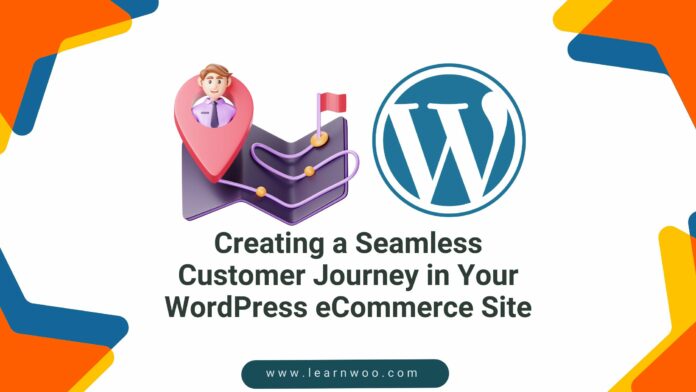Success with your WordPress eCommerce site depends on creating a seamless customer journey!
While the digital landscape is changing, organizations need to prioritize the user experience to remain competitive.
The nuances of WordPress eCommerce site optimization will be covered here, from the point at which a visitor lands on your page until the point of final checkout.
Personalized shopping experiences, streamlined navigation, and an understanding of customer behavior are a few tactics.
You can turn your website into a user-friendly paradise that increases engagement, loyalty, and revenue by putting these strategies into practice.
Learn how to create a seamless customer journey in your WordPress eCommerce site!


Understand User Behavior
Understanding how visitors interact with your WordPress eCommerce site is essential to creating a seamless customer journey.
Recognizing trends, issues, and preferences can be made easier with an understanding of user behavior and preferences.
To find out which pages are the most popular, where visitors are most likely to depart, and what actions result in conversions, start by reviewing your website’s analytics.
Heatmaps and session logs are particularly useful if you want to see how users navigate your website and pinpoint any unclear or annoying places.
Armed with this data, you can remodel unsuccessful customer experiences, optimizing page layouts, navigation paths, and product placements to better align with user expectations.
The key to a successful customer journey in your WordPress eCommerce site is continuously refining and adapting based on real-time user feedback and behavior.


Streamline Navigation
Streamlining navigation is essential for seamlessly guiding visitors through their shopping journey. So do the following:
- Organize your products into clear and intuitive categories and subcategories for easy access to desired items.
- Implement a prominent search bar with autocomplete functionality to help users quickly find what they’re looking for.
- Simplify your menu structure by minimizing clutter and prioritizing essential pages such as product listings, cart, and checkout.
- Use breadcrumb navigation to provide users with a clear path to previous pages, enhancing overall site usability.
- Regularly audit your site’s navigation to identify any bottlenecks or areas for improvement, and don’t hesitate to seek feedback from real users to refine navigation further.
Optimize Product Pages
Visitors to your product pages should be drawn in and encouraged to make a purchase. Writing engrossing product descriptions that emphasize salient features and advantages is the first step.
You’ll therefore handle possible buyer apprehensions and objections before they ever come up for discussion. Including high-quality photos taken from various perspectives is also a smart idea to provide the goods with a clear visual representation.
Incorporate feedback from customers to establish credibility and trust, as well as to reassure prospective customers about the quality and satisfaction of the product.
To help users add things to their cart and finish the transaction, make sure your calls to action are visible and easy to understand.
Remember to frequently update and refresh your product pages to maintain interesting and relevant material.
Lastly, you can always draw inspiration from successful eCommerce sites and adapt proven product page design inspirations to suit your brand and audience.
Personalize the Shopping Experience
This strategy is key to creating a seamless customer journey by significantly enhancing customer satisfaction and driving repeat purchases.
For instance, utilize customer data to offer personalized product recommendations based on past purchases, browsing history, and preferences. That way, you can guide users to relevant items they’re likely to love.
Implement dynamic content modules that adjust in real time based on user behavior. This content should showcase tailored offers, promotions, and product suggestions to maximize engagement and conversion rates.
Lastly, leverage email marketing automation to deliver personalized communication to your customers. Simple things such as birthday discounts or abandoned cart reminders help you nurture relationships and encourage repeat business.
It enables you to create a more meaningful and enjoyable customer shopping journey, fostering loyalty and long-term success.


Enhance Mobile Responsiveness
Because more and more people are shopping on smartphones and tablets, you need to make sure your website works well and is visually appealing on these platforms as well.
Make sure your WordPress eCommerce site is mobile-first from the outset to ensure a smooth consumer experience.
This implies that to provide a consistent user experience across all devices, you should prioritize components like touch-friendly navigation and responsive design.
To guarantee quick loading speeds on mobile devices, always optimize photos and other materials. Loading speed is also important. You’ll be able to lower bounce rates and raise user happiness as a consequence.
Of course, to make the shopping process easier for mobile consumers, mobile-specific features like mobile wallets and one-click checkout should be added.
Regularly test your site’s performance on various mobile devices and screen sizes to promptly identify and address any issues.
Provide Exceptional Customer Support
Gaining the audience’s trust and loyalty requires allowing them to contact your company and address any possible problems.
Therefore, make sure to provide a variety of avenues for consumer contact, such as phone, email, and live chat, to accommodate a range of tastes and requirements.
It is imperative that you swiftly address any questions or concerns raised by customers to show that you are committed to their satisfaction and to effectively resolving difficulties.
Establish a thorough FAQ section to answer frequently asked questions and give customers options for self-service. Also, explore customer support software to find the one that best suits your business.
This will allow you to streamline communication, track interactions, and manage support tickets effectively. Continuously gather customer feedback to identify improvement areas in your support process and make necessary adjustments.


Elevate the Customer Journey in Your WordPress eCommerce Site!
Creating a seamless customer journey in your WordPress eCommerce site is vital for driving engagement and increasing sales.
Understanding user behavior and streamlining navigation can help you guide visitors effortlessly through their shopping experience.
In addition, providing exceptional customer support ensures trust and loyalty. Continuously refine your strategies and adapt to evolving customer needs to thrive in the competitive eCommerce landscape.
FAQs
How can my WordPress eCommerce site’s user activity be analyzed?
You can make use of programs like Google Analytics, which offers data on user demographics, site traffic, and activity patterns. Additional tools that provide visual representations of user interaction with your website are heat maps and session recordings.
How can I make the navigation on my eCommerce site more efficient?
Sort the products first into distinct categories and subcategories. Include a search bar that is easily visible for convenience. To ensure that consumers are guided through your journey with ease, use breadcrumb navigation and simplify your menu layout.
How can I give my customers a more customized buying experience?
Provide individualized product suggestions using client data and leverage user behavior to inform the implementation of dynamic content modules. Use email marketing automation to give incentives and customized communications as well.
Why is my eCommerce site’s mobile responsiveness important?
More and more people are using mobile devices for shopping. Mobile optimization increases user satisfaction, lowers bounce rates, and eventually increases conversion rates.
What resources can I use to offer top-notch customer service?
Examine your options for customer support software, such as Zendesk, Freshdesk, or Help Scout, which provide capabilities like ticket management, live chat, and knowledge bases.











